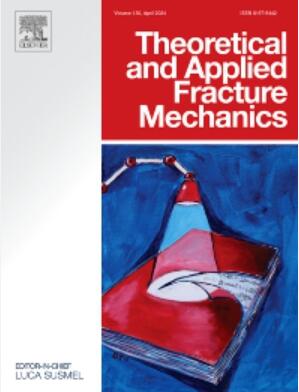Influence of angles between anchor rod and cracks on the bearing mechanism of anchored rocks: Insights from the perspective of AE, DSCM and IRT
IF 5.6
2区 工程技术
Q1 ENGINEERING, MECHANICAL
引用次数: 0
Abstract
Localized failures resulting from fractures in weakly cemented surrounding rocks can significantly contribute to overall instability in rock engineering. As the engineering geological conditions deteriorating, the mechanical behavior of these weakly cemented rocks exhibiting cracks becomes increasingly intricate. To investigate the anchoring mechanics of such rocks, particularly the impact of the angle between anchor rods and cracks on their bearing capacity, a viewable biaxial loading apparatus was developed. This apparatus was utilized in conjunction with acoustic emission (AE), digital speckle correlation methods (DSCM), and infrared thermography (IRT) to conduct biaxial loading tests on weakly cemented rocks with prefabricated cracks. The findings from these tests reveal that the stress–strain curve of anchored rocks can be categorized into distinct stages: compaction, elastic deformation, plastic deformation, and residual deformation, with the strain during the residual deformation stage comprising 46.9 % to 58.7 % of the total strain. When the angle between the anchor rod and the prefabricated cracks is ≤ 60°, significant tensile failure is observed due to the interconnection of the prefabricated cracks. Conversely, when the angle is ≥ 75°, only minor tensile failure occurs without any penetration of the cracks. As the angle increases, the number of frequency bands within the 200–300 kHz range diminishes, leading to a more uniform distribution of primary frequency signals in the 400–500 kHz range. Following the onset of unstable propagation in secondary cracks, the duration of AE events occurring near the crack tip (within a distance < 2 mm) typically exceeds 500 μs, with high-energy AE events of at least 0.1 × 10-10 aJ being recorded at the tips of these secondary cracks.
锚杆与裂缝夹角对锚固岩体承载机制的影响——基于AE、DSCM和IRT的启示
在岩石工程中,由弱胶结围岩裂缝引起的局部破坏是导致整体失稳的重要因素。随着工程地质条件的恶化,这些弱胶结岩石的力学行为变得越来越复杂。为了研究此类岩石的锚固力学,特别是锚杆与裂缝之间的角度对其承载能力的影响,开发了可视双轴加载装置。该仪器与声发射(AE)、数字散斑相关方法(DSCM)和红外热像仪(IRT)相结合,对带有预制裂缝的弱胶结岩石进行了双轴加载试验。结果表明:锚固岩体的应力-应变曲线可划分为压实、弹性变形、塑性变形和残余变形四个阶段,残余变形阶段的应变占总应变的46.9% ~ 58.7%;当锚杆与预制裂缝夹角≤60°时,由于预制裂缝相互连接,出现了明显的拉伸破坏。反之,当角≥75°时,只发生轻微的拉伸破坏,裂纹没有渗透。随着角度的增加,200-300 kHz范围内的频带数量减少,导致400-500 kHz范围内的主频信号分布更加均匀。随着次级裂纹中不稳定扩展的开始,在裂纹尖端附近发生的声发射事件的持续时间(距离<;在这些次生裂纹尖端处记录到至少0.1 × 10-10 aJ的高能声发射事件。
本文章由计算机程序翻译,如有差异,请以英文原文为准。
求助全文
约1分钟内获得全文
求助全文
来源期刊

Theoretical and Applied Fracture Mechanics
工程技术-工程:机械
CiteScore
8.40
自引率
18.90%
发文量
435
审稿时长
37 days
期刊介绍:
Theoretical and Applied Fracture Mechanics'' aims & scopes have been re-designed to cover both the theoretical, applied, and numerical aspects associated with those cracking related phenomena taking place, at a micro-, meso-, and macroscopic level, in materials/components/structures of any kind.
The journal aims to cover the cracking/mechanical behaviour of materials/components/structures in those situations involving both time-independent and time-dependent system of external forces/moments (such as, for instance, quasi-static, impulsive, impact, blasting, creep, contact, and fatigue loading). Since, under the above circumstances, the mechanical behaviour of cracked materials/components/structures is also affected by the environmental conditions, the journal would consider also those theoretical/experimental research works investigating the effect of external variables such as, for instance, the effect of corrosive environments as well as of high/low-temperature.
 求助内容:
求助内容: 应助结果提醒方式:
应助结果提醒方式:


